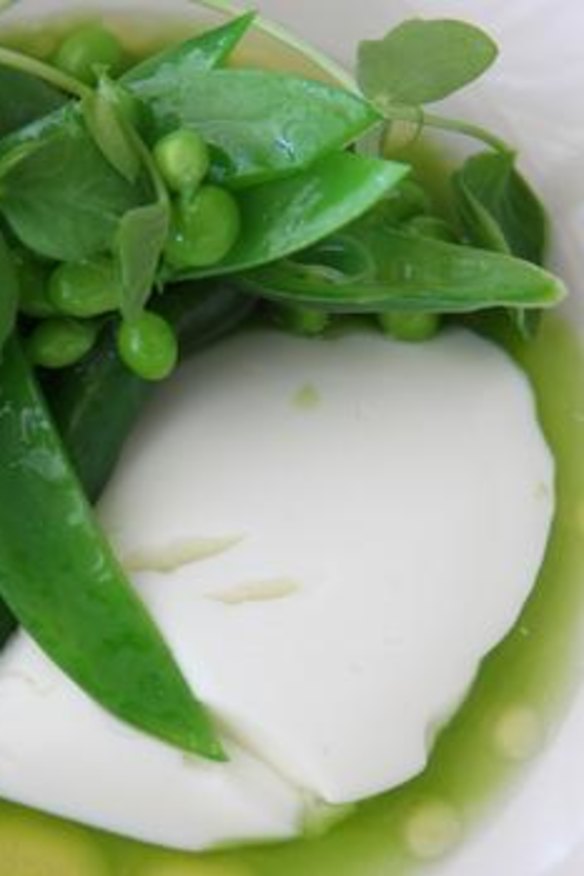Sixpenny

16/20
Contemporary$$$
Why Sixpenny? Because there was a time when Australian restaurants fed the working classes filling meals of soup, meat and pudding accompanied by cups of tea and bread and butter, all for the princely sum of sixpence. Sixpenny restaurants were hugely popular in the 1850s but, according to one visitor, ''they never change throughout the 365 days of the year. Invariably beef, mutton and poultry, boiled and roasted, roasted and boiled; the everlasting dish of potatoes, and sometimes some soggy boiled vegetables''.
It's sufficiently intriguing, nevertheless, that two former Josephine Pignolet Best Young Chefs have chosen to pay tribute to the past rather than doing the Gen-Y thing of assuming everything old is bad and everything new is good. Nor have they chosen to go the dude-food route and for that we bless them.
James Parry, 33, and Daniel Puskas, 30, have worked in some of the world's finest kitchens -
Parry at Mugaritz in Spain and Copenhagen's Noma, and Puskas at New York's WD-50 and Alinea in Chicago. Puskas relinquished his prime co-chef position at the current Restaurant of the Year, Sepia, to once again team up with his former Oscillate Wildly colleague. Together, with former Codfather partner Chris Sharp, the pair has taken over a sweet little 1907 corner site, transforming it into a quietly mature, Nordically inspired dining space of bare-but-beautiful dark tables and chairs surrounding a central wooden serving station.
In a nod to modern dining's no-barriers philosophy, the chefs bring the food to the tables. Parry is first, bearing a pat of creamy ''mascarpone'' butter and a loaf of good, house-made crusty sourdough.
In a flurry of starters reminiscent of Copenhagen's Noma, out comes
a pale and pretty pickle of baby veg from the chefs' garden plot in Bowral and some super-fine, super-crunchy malt and vinegar crisps that cling together like atomic clusters. Next comes a knuckle sandwich (Cutest Title Award), a tiny brioche toastie of soft ham hock with apple and mustard seed jelly. Next to it - I'm not sure why - is a single duck's tongue, free of cartilage, cushioned on a baby cos leaf.
And so it goes; the food is freshly put together as if just picked and plated. No heavy sauces, no huge protein hits, and definitely no ''soggy boiled vegetables''; just beautifully balanced, gently textural, lightly savoury small courses. Key notes are herbal, botanical, floral, earthy. There are roots, shoots, leaves, nuts, seeds and grasses as lead accompaniments instead of potatoes, grains and pulses. A gentle, giving fillet of snapper is dressed with pumpkin seed cream, buttery leeks and slightly mealy, crushed roasted pumpkin seeds. A white-on-white puddle of mudcrab in a silky macadamia nut cream is one of those sneak-up-on-you dishes; the flavours rooted in Australia, yet heaven-sent.
Only one dish goes awry for me and that's a daylily bud, coated in caramel. Thrilled about the daylily (Hemerocallis fulva), unconvinced by the caramel.
Then along comes ''peas, beans and cheese'', a thoroughly grounded dish highlighting more bounty from Bowral, teamed with pillow-soft curd. Next, a plug of roasted and relaxed Suffolk lamb with sweet onion broth is charmingly topped with sweet onions.
Desserts are not as immediately engaging; perhaps because they play in a narrower field of ice-cream, sour lemon and caramel. Or perhaps because they come as the final three courses in the flow of things, when hunger, appetite and the need for entertainment have peaked. The latter theory then gets blown out of the water by the unseemly scrambling at our table to get our hands in the ''cookie jar'' of petits fours; a glass preserving jar filled with micro-lamingtons, butternut snaps, kingstons and monte carlos.
You can choose to have dinner served with matching wines for an extra $55, or the well-mannered wait staff will introduce you to a few highlights from the wide-ranging, sweetly put-together list, most of which is sourced from NSW and the ACT. I scored a clean yet complex NV Centennial Blanc de Blanc ($13 a glass) from the Southern Highlands; a fresh, savoury Mount Majura Chardonnay from Canberra ($13) and a cracker of a 2009 Tertini Pinot Noir, again from the Southern Highlands ($90).
Sixpenny may be small but it's a significant opening for Sydney, the first of what could be a whole new breed of small, personal, young-chef, post-Noma restaurants with an emphasis on garden produce and sustainability. The cooking is accomplished, the flavours clean and seasonally matched, the effort, intent and ambition palpable. It will steal your heart away.
tdurack@smh.com
We use the same ratings in our reviews as The Sydney Morning Herald Good Food Guide.
The Low-down
Best bit The cookie-jar petits fours.
Worst bit Maybe a little too reminiscent of Noma.
Go-to dish Peas, beans and cheese.
Sixpenny
Address 83 Percival Road, Stanmore, 9572 6666, sixpenny.com.au.
Open Lunch Sat-Sun;dinner Wed-Sat.
Licensed Yes.
Cost Six-course menu $105pp, plus wine; eight courses $125, plus wine.
Score indicates Capable of greatness.
Restaurant reviews, news and the hottest openings served to your inbox.
Sign up- More:
- Stanmore
- Sydney
- Contemporary
- Licensed
- Accepts bookings
- Date night
- Bar
- Vegetarian-friendly
- Degustation
- Gluten-free options
- Sixpenny
- Reviews
From our partners
Original URL: https://www.smh.com.au/goodfood/sydney-eating-out/sixpenny-20120325-2ajnn.html
